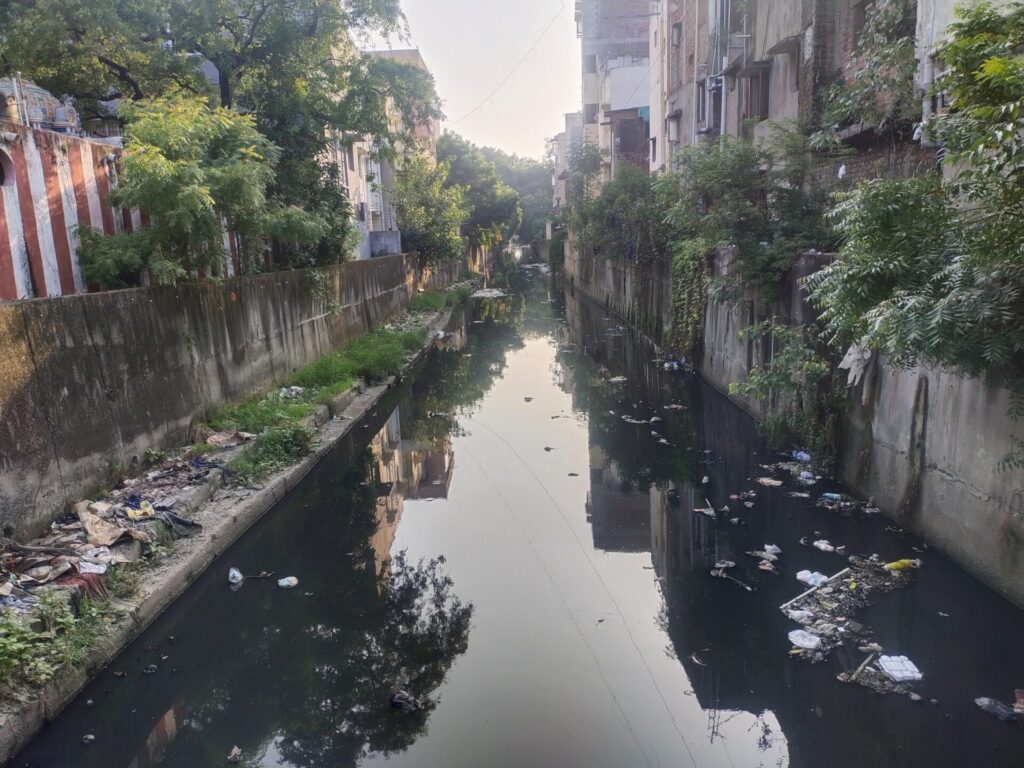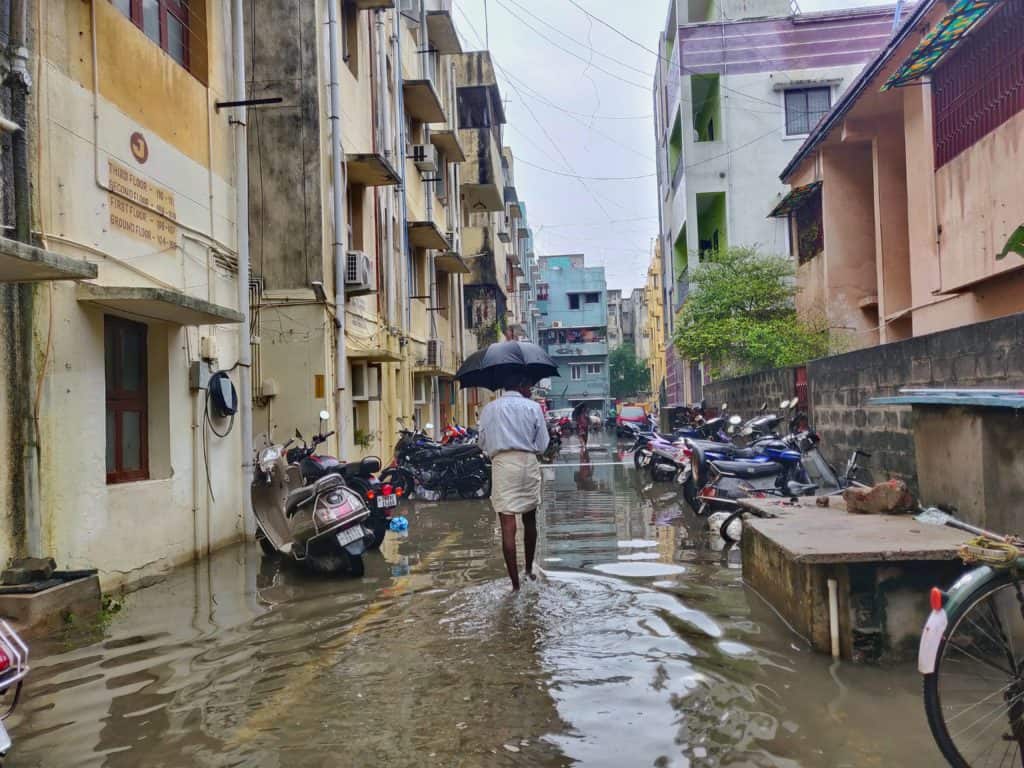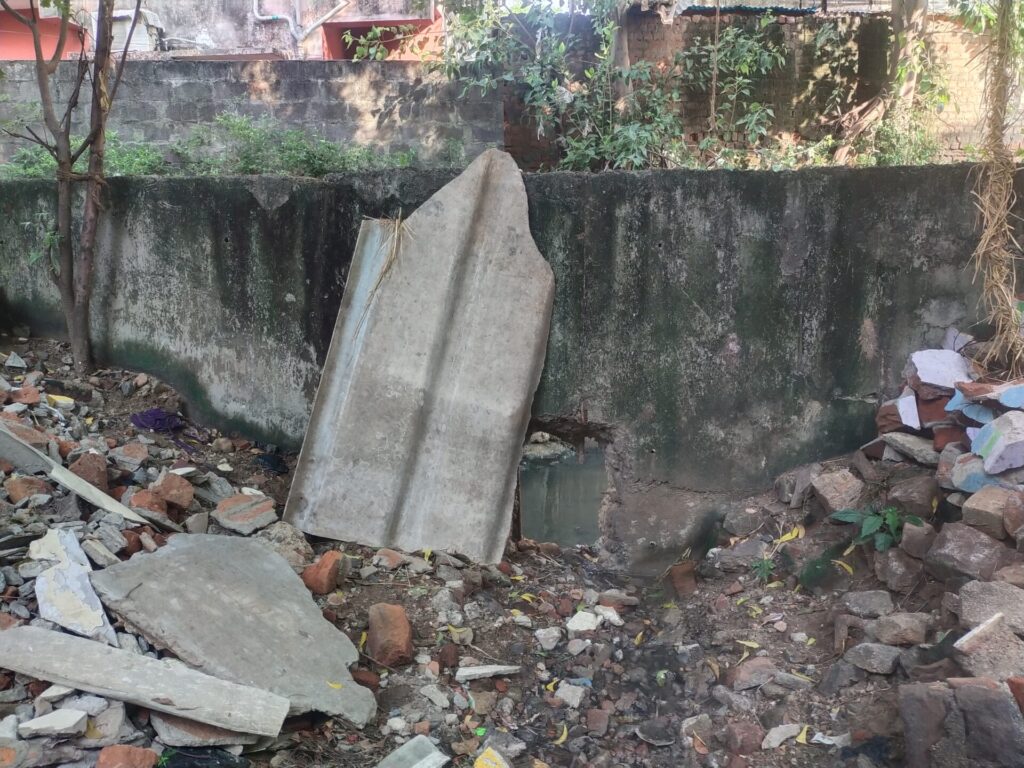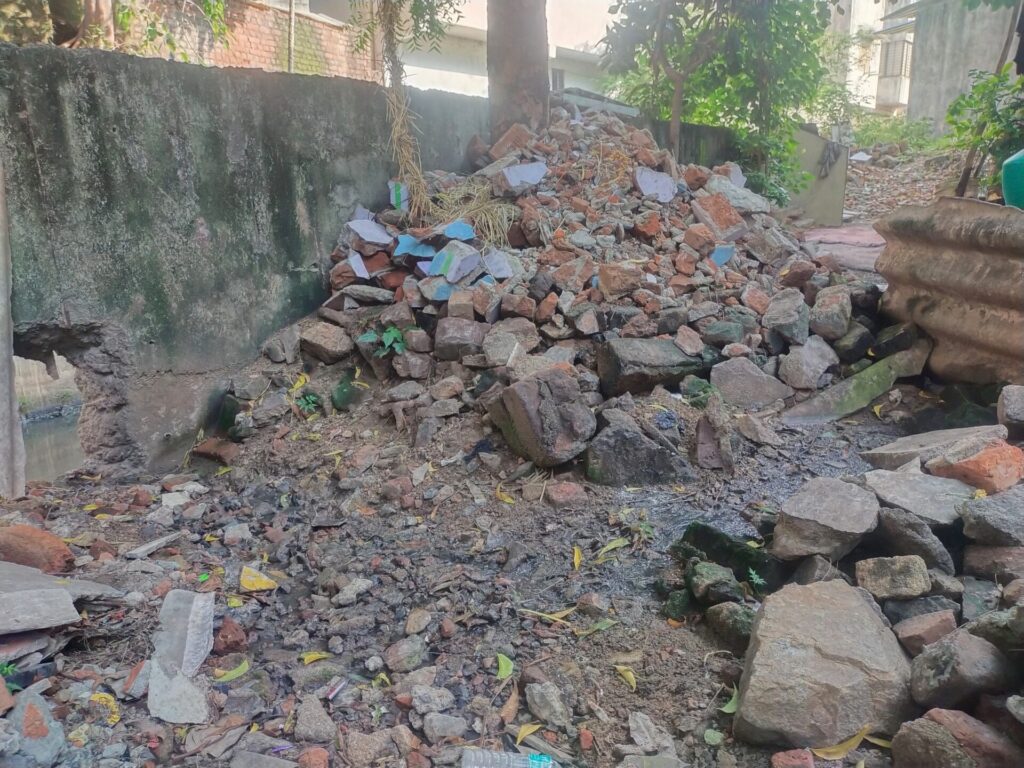Black, foul-smelling, stagnant water – this is what one will find when they go in search of the Mambalam Canal which was once one of the significant freshwater canals in the city.
In its heydays, the canal used to carry surplus water from two major tanks – the Nungambakkam tank and the Mambalam tank – that existed some four decades ago. Due to urbanisation, the entire watershed area of these tanks now has residential and commercial establishments in it.
The path followed by the original canal starts near Valluvar Kottam and passes through T Nagar and CIT Nagar before draining into the Adyar River near the Nandanam Golf Course.
In my quest to trace the Mambalam Canal from its origin to end, I was able to find only a few parts of it, with the canal’s decay and Metro rail construction obscuring much of the view.
Old images of the canal have all but faded from the memory of the locals.
“I have lived here for almost four decades and I remember the canal being the same (polluted) all the time. During monsoon, the black water from the canal will overflow into the roads and inundate the streets for several days,” says Sultana, a resident of CIT Nagar.
Attempts to restore the Mambalam Canal
As with the Cooum, there have been repeated attempts to fix the Mambalam Canal.
In January 2021, the Greater Chennai Corporation floated five tenders under the Mambalam Canal restoration project to create greenery and recreational facilities along the canal. Contractors were selected to carry out the works for a total of 1,750 metres between Vinothya Main Road and Thyagaraya Road. The project was proposed in two phases under the Smart City fund at a total cost of around Rs 106 crore.
According to the project proposal, there were plans to lay a bicycle path, walkways, parks, and seating among many other components that focused on beautification rather than restoration of the canal.
A large amount of debris was dumped into the Mambalam Canal to implement the project.
Less than ten months had passed since the project began. Around 5% of the work had been completed and gradually the Mambalam Canal was to be made into a recreational space. However, nature had different plans. After the onset of the northeast monsoon in 2021, rains started lashing the city.
The Mambalam Canal which was supposed to drain the rainwater from the stormwater drains in the surrounding areas was filled with construction debris that disrupted the free flow of water. The stormwater drains were also clogged.
As a result, the rainwater mixed with the polluted water in the canal started overflowing on the roads. This water also gushed into the houses making the lives of residents in the area a nightmare for the next few days
“My house is located opposite Ranganathan Street. My 96-year-old mother, who was unable to walk, was in the house on the ground floor, while we were on the first floor. After a night-long heavy downpour, the water started entering our house on the ground floor. We had to shift her to the first floor and then shift her to a friend’s place in Chrompet through an ambulance after the dirty water flooded our house,” says Jayaraman VS, a resident of T Nagar for the past 40 years.
Jayaraman and the residents of seven other flats on their premises had to spend a total sum of Rs 11,55,000 to make the premises inhabitable after the floods.
After this incident and the anger of the residents in the aftermath, in July 2022, the Corporation Council passed a resolution to revise the Mambalam Canal restoration project. The local body dropped the proposal that focused on the beautification of the Mambalam Canal. The focus was shifted to flood mitigation.
The recommendations given by the Thirupugazh Committee which was appointed to study the reasons and solutions for the flooding in Chennai were incorporated in the new plan to restore the canal.
Read more: All that’s wrong with stormwater drains in Chennai and how to fix them
Root causes remain unaddressed
While many months have passed, residents do not see any significant changes on the ground with regard to the state of the canal.
“I do not find any restoration work going on in Mambalam Canal now. The elected representatives and the officials visit the canal once in a while in the name of inspection and take pictures. They do not interact with the residents or take any initiative for public consultation before implementing the project,” says Kannan Balachandran, Secretary to T Nagar Resident’s Welfare Association. He also adds that the residents are not aware of the project details.
Speaking on the root causes of flooding in the T Nagar area, he says that the stormwater drains, which are said to be a solution, are not serving the purpose. “We can find sewage water running in any storm water drains. Every other commercial establishment in T Nagar, especially the ones in North Usman Road, uses stormwater drains as sewage drains. The local body seems to have no control over them,” he says.
“A famous jewellery shop in T Nagar has a dining hall for their employees in the same area. If the food goes to waste, they dump the food into the stormwater drains regularly. This clogs the stormwater drains which end up in the Mambalam Canal. During monsoons, since both the stormwater drains and the canal are clogged with garbage, there is no free flow of water in the canal. This results in inundation in residential areas,” he adds.
Kannan also approached the court seeking respite.
“The court ordered to remove the dining hall but to this day the corporation has not taken any action,” he alleges.
Mambalam Canal is the point to which the stormwater drains from the residential areas are connected.
“Most of the residential establishments in the locality were built more than four or five decades ago. There was no multi-storey construction back then. As years passed, the population increased but the infrastructure remained the same,” says Jayaraman. “The civic body also increased the road height resulting in the premises of the residential complexes falling lower than the road height. Subsequently, the rainwater flows down to the residential complexes from the road during every monsoon. The stormwater drains, which are said to be a solution to this issue, have not been helpful either as it is also constructed at the elevated height of the road,”.
The residents have petitioned the Greater Chennai Corporation multiple times regarding this issue but to no avail.
Read more: Looking beyond stormwater drains to realise the dream of a flood-free Chennai
Poor bear the brunt of Mambalam Canal’s degradation
While the corporation has been proposing stormwater drains as a solution to the flooding in localities around the Mambalam Canal, there are also areas that lack even the basic amenities. Taking a walk around the canal will lead to narrow roads that end up near the walls of the canal.
Here, one can find multistorey buildings on one side of the Mambalam Canal, while the other side evidently houses people from low-income communities.

Masthana, who lives right next to the wall of the Mambalam Canal, says that the residents from the multi-storey buildings on one side of the canal often throw huge bags of garbage into the canal.
“Since they are rich people, we cannot fight them. But, we are the ones who bear the brunt. The polluted stagnant water is a breeding ground for mosquitoes. With children and senior citizens in the locality, it becomes a huge health hazard,” she says.
While the people living in multistorey buildings continue to violate the rules despite having better facilities, Masthana says that the residents in low-income settlements along the banks of the canal lack basic amenities and civic infrastructure such as stormwater drains.
“When the water in the canal increases, it starts flowing into our houses directly. We use asbestos sheets to block the water from entering into the houses but it does not help much,” she says.
Notably, as they do not have underground drainage facilities, the residents also end up draining the water used for washing clothes, and vessels and bathing into the canal.
Involving the public in fixing Mambalam Canal
Several locals say that the workers from GCC clean the Mambalam Canal at regular intervals but the continued dumping of waste makes the exercise futile.
“We have seen them cleaning the canal with JCBs and some machines to pull out the garbage dumped inside the canal. It is impossible to manually get inside the canal and clean it as there will be glass pieces and other harmful substances inside. Besides, it is totally unsafe to get inside polluted water. However, picking out the garbage from the canal is not helpful as the residents do not stop their behaviour,” notes Ram, a local resident.
A local official also says that their major challenge has been in stopping the residents from throwing the garbage into the canal. “We removed the construction debris dumped earlier and de-silted the canal. Unless the residents practice proper solid waste management, it is going to be hard to go forward,” he says.
An official source says that the Thirupugazh Committee has given elaborate recommendations to restore the Mambalam Canal.
“In order to prevent flooding in areas around Valluvar Kottam, where the erstwhile Nungambakkam tank was there, the committee has recommended constructing stormwater drain networks with disposal point to Mambalam Canal. We are trying our best to restore the canal to at least a five-year return period. There is much to be done even after that,” says the source.
Residents also point out that it is important to make the recommendations of the Thirupugazh Committee public. Holding public consultations before implementing the project will help create awareness among the residents and address the root cause of the canal’s deterioration.
Every water body has a hydrological function. When that is disturbed, we will have to face the consequences. That is exactly the case with the Mambalam Canal.
It is sad that even the residents who have lived in the locality for over four decades do not have a memory of fresh water in the Mambalam Canal. But, a worse failure would be to not leave even the remaining traces of the canal for future generations.


